Discover a hidden gem in the UNESCO Biosphere Reserve with pristine beaches and vibrant marine life in Baa Atoll
Located in the stunning Baa Atoll, Dhonfanu Island is a serene local island that offers visitors an authentic glimpse into traditional Maldivian island life. This peaceful island remains largely untouched by mass tourism, preserving its natural beauty and cultural heritage within the UNESCO Biosphere Reserve.
What makes Dhonfanu special is its pristine environment and strong community bonds. Unlike more developed islands, Dhonfanu maintains its traditional way of life centered around fishing, small-scale agriculture, and handicrafts. The island's relatively small population creates an intimate atmosphere where visitors quickly feel welcomed into the community rather than treated as tourists.
Visitors to Dhonfanu are drawn by its untouched beaches, exceptional house reef for snorkeling, and proximity to world-famous marine protected areas like Hanifaru Bay. The island's slower pace of life, stunning marine environment, and genuine cultural experiences make it an ideal destination for travelers seeking to discover the authentic heart of the Maldives beyond the luxury resorts.
Dhonfanu Island is situated in the northeastern part of Baa Atoll, approximately 120 kilometers northwest of Male. The island occupies a strategic position within the UNESCO Biosphere Reserve, surrounded by crystal-clear waters and vibrant coral reefs.
Its location provides excellent access to some of the region's most pristine marine environments, including the world-famous Hanifaru Bay, known for its seasonal aggregations of manta rays and whale sharks. Dhonfanu's position offers a more secluded experience compared to some of the busier islands in the atoll, while still being accessible to travelers.
Dhonfanu Island is renowned for its strong fishing traditions that have sustained the community for generations. Fishing remains not just an economic activity but a cultural cornerstone that shapes daily life, community relationships, and local identity.

Dhonfanu fishermen continue to practice traditional pole-and-line fishing, a sustainable method that has been used for centuries in the Maldives and prevents overfishing and bycatch while preserving marine ecosystems.
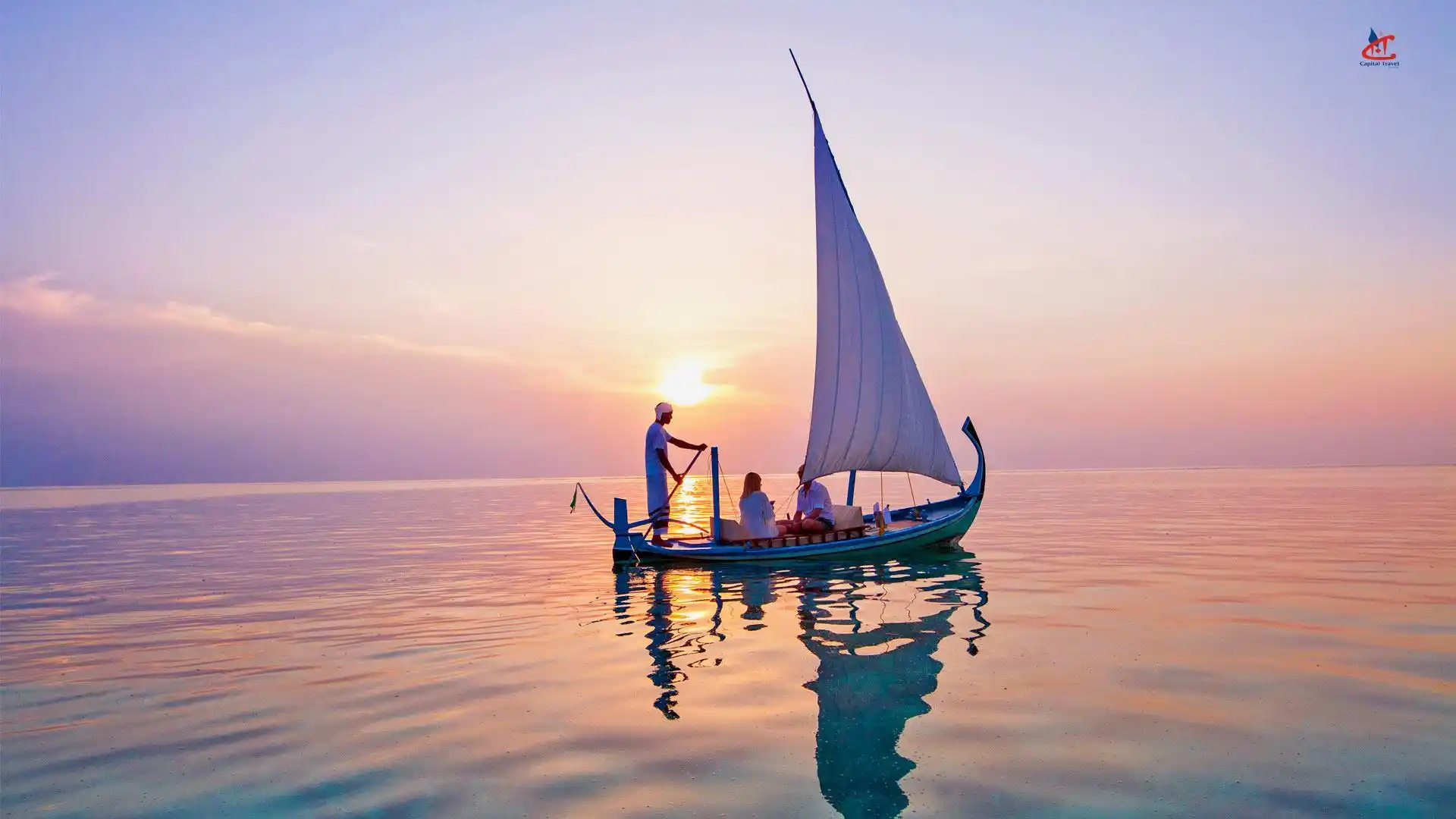
The island's harbor is home to traditional fishing dhonis (wooden boats) alongside more modern vessels. These boats, often hand-crafted using techniques passed down through generations, remain central to the island's fishing fleet.
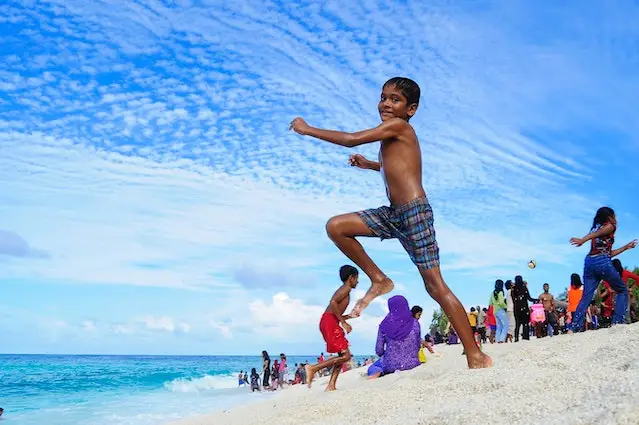
Fish processing remains a community activity, with families working together to clean, fillet, smoke, and dry the daily catch. These traditional preservation methods create specialty products like the famous Maldivian dried fish.

Travelers can participate in traditional sunset fishing trips with local fishermen, learning sustainable techniques while experiencing an authentic aspect of Maldivian culture handed down through generations.
Fishing permeates every aspect of Dhonfanu's culture:
This deep connection to the sea shapes not just livelihoods but the island's cultural identity and community bonds.
Dhonfanu's fishing community demonstrates impressive sustainability:
These practices have helped maintain healthy marine ecosystems around Dhonfanu for generations.
Dhonfanu offers a select range of accommodation options that focus on authentic experiences and local hospitality. While more limited than some of the larger islands, the accommodations here provide genuine warmth and a true connection to island life.

Several family-operated guesthouses offer clean, comfortable accommodations with a personal touch. These properties typically feature air-conditioned rooms with private bathrooms, home-cooked Maldivian meals, and direct access to local knowledge through the host families.
Price Range: $45-70 per night
Features: Authentic hospitality, home-cooked meals, cultural insights, local excursion arrangements

For travelers seeking deep cultural immersion, homestay experiences are available with local families. These provide the most authentic glimpse into island life, with guests sharing meals and daily activities with their host family while enjoying basic but comfortable accommodation.
Price Range: $35-55 per night, including meals
Features: Cultural immersion, family interaction, traditional meals, daily island activities

A small number of simple beachfront cottages offer a more private experience while maintaining a connection to local culture. These modest accommodations provide direct beach access and a peaceful environment for those seeking a balance of comfort and authenticity.
Price Range: $65-95 per night
Features: Beach access, privacy, basic amenities, natural surroundings
Dhonfanu offers basic facilities that meet visitor needs while maintaining its authentic island character. The infrastructure supports daily life for locals and provides essential services for travelers without compromising the island's traditional atmosphere.
The island has several small local shops providing basic necessities, snacks, beverages, and toiletries. These family-run convenience stores stock essentials for both locals and visitors.
Most meals are provided by guesthouses featuring fresh seafood and traditional Maldivian cuisine. The island also has a couple of small local cafés serving snacks, tea, and coffee in a casual setting.
Dhonfanu has a small health center with basic medical services. For serious conditions, patients are transferred to Eydhafushi (atoll capital) or Male for treatment.
Mobile coverage is available from both Dhiraagu and Ooredoo networks. Most guesthouses offer Wi-Fi, though connectivity may be slower than in more developed areas.
The island relies on a combination of rainwater collection systems and groundwater. Most guesthouses provide filtered drinking water for guests, and bottled water is available in local shops.
Dhonfanu has a central power plant providing electricity throughout the island. Power is generally reliable, though occasional brief outages may occur. Some accommodations have backup generators.
The island has a central mosque serving the local population. Visitors are welcome to view the exterior but should dress modestly and respect prayer times.
Dhonfanu has a small harbor that serves fishing boats and visitor transfers. The harbor area is a hub of activity, especially when fishing boats return with their daily catch.
Dhonfanu is blessed with pristine beaches and a spectacular marine environment. The island's location within the UNESCO Biosphere Reserve has helped preserve the surrounding reefs in excellent condition, making it a paradise for snorkeling and marine enthusiasts.
Dhonfanu features stunning white sand beaches that encircle much of the island. The eastern beach is particularly impressive, with powdery sand and crystal-clear turquoise waters that create postcard-perfect vistas. The western beach offers a more sheltered environment, with calm waters ideal for swimming and gentle relaxation.
The island has a designated "bikini beach" on its northern shore where tourists can wear Western-style swimwear. This beautiful stretch of sand provides a relaxing environment while respecting local cultural norms. The remaining beaches require modest dress as they are used by the local community.
One of Dhonfanu's greatest natural assets is its vibrant house reef, accessible directly from several points around the island. The reef features healthy coral formations and abundant marine life, offering excellent snorkeling opportunities just steps from the shore. The house reef's accessibility makes it possible to enjoy multiple snorkeling sessions throughout the day without needing boat transportation.


The waters around Dhonfanu Island offer exceptional marine biodiversity, making it a paradise for underwater enthusiasts:
The island's location within the UNESCO Biosphere Reserve has helped preserve Dhonfanu's marine environment in exceptional condition.
Dhonfanu offers a range of activities that blend natural experiences with cultural immersion. The island's authentic character provides visitors with opportunities to connect with both nature and traditional Maldivian lifestyle.





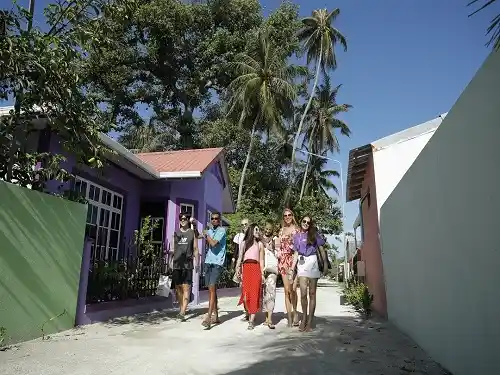
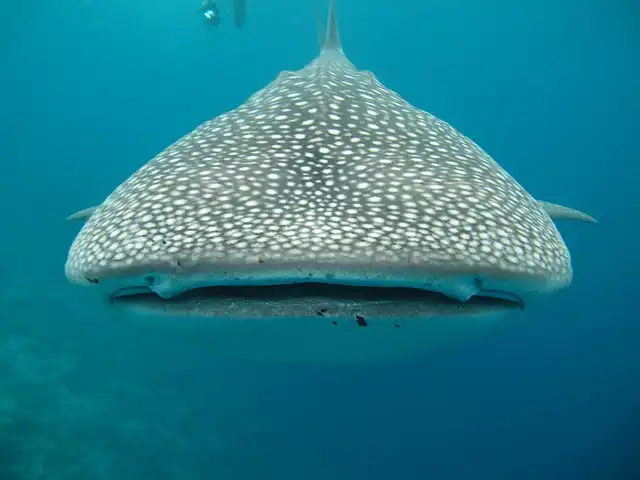

Dhonfanu is home to a close-knit community of approximately 800 residents who maintain strong traditional values while adapting to modern influences. The island's population is known for its warm hospitality, fishing expertise, and preservation of authentic Maldivian culture.
Daily life on Dhonfanu follows the rhythm of traditional island routines, centered around fishing, prayer times, and community gatherings. Mornings begin early as fishing boats depart before dawn, returning mid-morning with their catch. The island awakens with the call to prayer, followed by a day of work, family responsibilities, and community interactions. Evenings often find residents gathering in public spaces, sharing news, and socializing as the day cools.
Dhonfanu preserves many traditional Maldivian customs and cultural practices. Religious observances play an important role in community life, with festivals like Eid celebrated enthusiastically. Cultural expressions such as Boduberu performances remain vibrant, while traditional crafts including lacquer work, mat weaving, and boat building are still practiced by skilled artisans.
What makes Dhonfanu's community special is its strong sense of unity and mutual support. Island residents work cooperatively on community projects, share resources, and maintain close social bonds. This communal approach to life creates a warm atmosphere where visitors are genuinely welcomed and quickly made to feel part of the island's extended family rather than just tourists passing through.
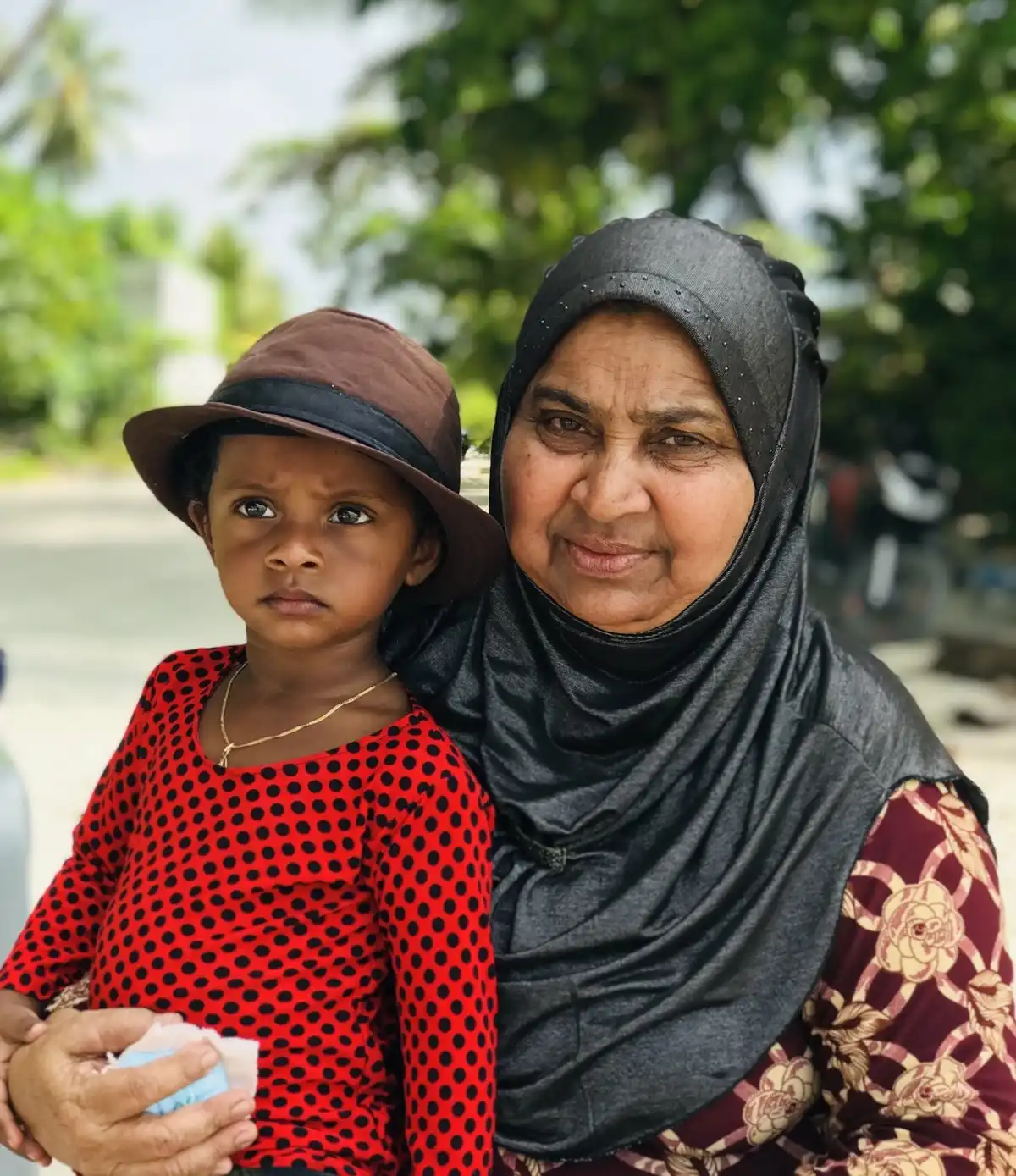

Hear what previous visitors have to say about their stay on Dhonfanu Island:
My week on Dhonfanu was the highlight of my Maldives trip. I was looking for an authentic experience away from the tourist crowds, and this island delivered perfectly. My guesthouse was simple but immaculately clean, with the most delicious home-cooked Maldivian food I've ever tasted - fresh fish prepared in traditional ways every day. The house reef was incredible for snorkeling, with healthy coral and so many fish species right off the beach. What made my stay special was the warmth of the people - everyone from children to elders greeted me with smiles and genuine curiosity. The excursion to Hanifaru Bay was absolutely breathtaking - swimming with dozens of manta rays was a once-in-a-lifetime experience. The beaches were pristine and often completely empty - it felt like having my own private paradise. If you want to experience the real Maldives beyond the luxury resorts, Dhonfanu offers the perfect balance of natural beauty, cultural immersion, and peaceful relaxation.
I chose Dhonfanu for a solo trip wanting to experience traditional island life, and it exceeded all my expectations. My stay at a family guesthouse provided insights into Maldivian culture that no resort could offer. My host family was incredibly welcoming, sharing meals, stories, and even teaching me basic Dhivehi phrases. The marine life around the island was spectacular - I went snorkeling daily and saw everything from reef sharks to turtles just a short swim from shore. One of my favorite experiences was joining the local fishermen for a traditional fishing trip at sunset, learning their techniques and watching them work with incredible skill. The catch was prepared for dinner that same evening! Being in the UNESCO Biosphere Reserve meant the coral reefs were in amazing condition. The island's pace of life is wonderfully slow and peaceful, perfect for disconnecting and relaxing. There aren't fancy restaurants or bars, but the authentic experiences and connections I made were far more valuable. For travelers who appreciate cultural immersion and natural beauty over luxury amenities, Dhonfanu provides a genuine Maldivian experience that's becoming increasingly rare.
Discover the genuine warmth, traditional culture, and natural beauty of Dhonfanu Island. Book your stay today for an unforgettable and authentic Maldivian experience in Baa Atoll's UNESCO Biosphere Reserve.
Plan Your TripDhonfanu Island is accessible via several transportation options. The most common route is by public ferry from Male, which operates twice a week (Monday and Thursday), departing at 8:30 AM and arriving at Dhonfanu around 3:30 PM. The ferry journey takes approximately 7 hours and costs about $4-6 per person. Alternatively, you can take a speedboat directly from Male to Dhonfanu, which takes about 3-4 hours and costs around $70-80 per person. For a faster route, you can take a domestic flight from Velana International Airport to Dharavandhoo (about 30 minutes), followed by a speedboat to Dhonfanu (approximately 25 minutes). This combined journey cuts travel time significantly but costs around $120-140. Most guesthouses can assist with arranging transfers and will provide detailed information about the best options based on your arrival date and preferences.
The best time to visit Dhonfanu Island depends on your interests. For general beach and snorkeling activities, the northeast monsoon season (November to April) brings dry, sunny weather with lower humidity and calmer seas. This period is ideal for water activities, with water visibility often exceeding 20-30 meters. January to March typically offers the most reliable weather conditions with minimal rainfall. If you're specifically interested in manta ray and whale shark encounters at nearby Hanifaru Bay, plan your visit between May and November, with peak season being June to October when plankton concentrations attract these magnificent creatures. The southwest monsoon season (May to October) brings occasional rain showers and slightly rougher seas, though there are still many sunny days. This period offers advantages including fewer tourists, lower prices, and the chance to witness the spectacular marine life aggregations in the UNESCO Biosphere Reserve. Water temperature remains warm (27-30°C/80-86°F) throughout the year, making Dhonfanu a viable destination in any season depending on your preferences.
Dhonfanu distinguishes itself from other local islands through its strategic location within the UNESCO Biosphere Reserve and its exceptional preservation of traditional Maldivian life. Unlike more developed islands that have seen significant tourism infrastructure, Dhonfanu maintains its authentic character with a community still primarily engaged in traditional fishing and island activities. The island's proximity to Hanifaru Bay, one of the world's most significant marine protected areas for manta rays and whale sharks, provides visitors with unique opportunities to witness these magnificent creatures during the season. Dhonfanu's house reef is particularly impressive, with healthy coral formations accessible directly from shore, offering exceptional snorkeling without boat trips. The island's beaches remain pristine and uncrowded, providing a more secluded experience than busier local islands. Dhonfanu also stands out for its strong fishing heritage, with visitors able to observe and participate in traditional fishing practices that have sustained the community for generations. For travelers seeking the increasingly rare experience of authentic Maldivian island life without sacrificing natural beauty or basic comforts, Dhonfanu offers a perfect balance that's becoming harder to find as tourism expands throughout the archipelago.
Yes, as Dhonfanu is a local inhabited island with a Muslim population, visitors are expected to dress modestly in public areas. Both men and women should cover shoulders and knees when walking around the village, visiting shops, or dining in local establishments. Men should wear t-shirts/shirts and shorts that reach the knee or longer. Women should wear t-shirts/blouses with sleeves and skirts/shorts/pants that cover the knees. Lightweight, loose-fitting clothing is ideal given the tropical climate. Swimwear (including bikinis) is only permitted at the designated "bikini beach" area on the northern shore of the island. When visiting the mosque or religious sites, women should cover their heads with a scarf. These dress code requirements are a sign of respect for local culture and traditions. It's worth noting that on excursions to uninhabited islands, sandbanks, or during resort day trips, Western-style swimwear is generally acceptable. When packing for your trip, include modest clothing for island activities along with your regular beachwear for designated areas.
The waters around Dhonfanu offer exceptional marine biodiversity, making it a paradise for snorkelers. The island's house reef features healthy coral formations with both hard corals (brain coral, staghorn coral, table coral) and colorful soft corals creating a vibrant underwater landscape. Reef fish are abundant, including various species of butterflyfish, angelfish, parrotfish, surgeonfish, and triggerfish displaying spectacular colors. Blacktip and whitetip reef sharks are commonly spotted patrolling the reef edges, particularly in the morning and late afternoon. Green and hawksbill sea turtles can be observed feeding on seagrass beds or resting among coral formations. Various ray species inhabit the surrounding waters, including eagle rays and stingrays often seen gliding over sandy areas adjacent to the reef. Moray eels, octopus, and reef cuttlefish provide fascinating encounters for observant snorkelers exploring coral crevices. During certain seasons, schools of jackfish, tuna, and trevally create impressive underwater spectacles. The nearby Hanifaru Bay (accessible by boat excursion) offers the opportunity to witness manta ray and whale shark aggregations during the southwest monsoon season (May-November). With water visibility often exceeding 20-30 meters during optimal conditions, snorkelers can enjoy clear views of this underwater paradise directly accessible from Dhonfanu's shores.